 In this story by Jorge Borges, a mystic arrives at the overgrown, burnt-out ruins of an ancient temple. Living as an ascetic, his purpose is to “dream” a man into existence, initiate him into the riddles of the universe, and send him to inhabit another temple. Before they part, he manipulates his creation’s memory so neither he nor anyone else will know he is a spirit. Later, on the point of death, the mystic learns that he, too, is the product of a dream. Themes include philosophical idealism, dreams vs. reality, the circle of life, creation, religion and spirituality. More…
In this story by Jorge Borges, a mystic arrives at the overgrown, burnt-out ruins of an ancient temple. Living as an ascetic, his purpose is to “dream” a man into existence, initiate him into the riddles of the universe, and send him to inhabit another temple. Before they part, he manipulates his creation’s memory so neither he nor anyone else will know he is a spirit. Later, on the point of death, the mystic learns that he, too, is the product of a dream. Themes include philosophical idealism, dreams vs. reality, the circle of life, creation, religion and spirituality. More…
Category Archives: Short Stories
Was it a Dream?
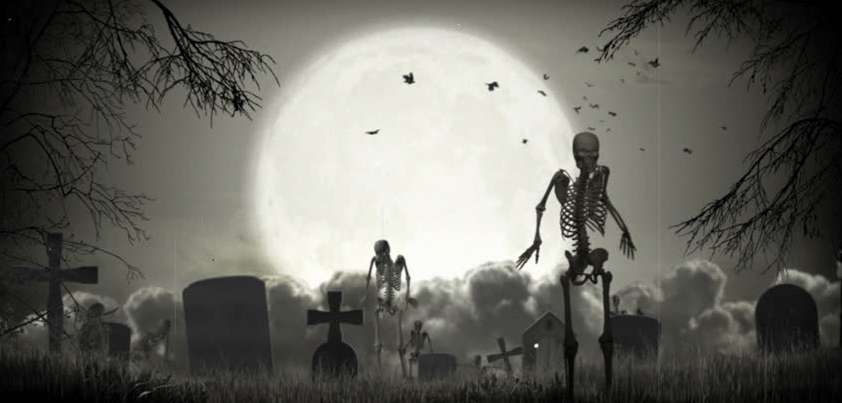 The question in the title of this Guy de Maupassant story could refer to two things: the blissful year the protagonist shared with his lover, or the vision he had while visiting her grave. Similarly, the feelings of emptiness and loss he experiences could be because of two things: the unexpected death of his lover, or what he learned/dreamed about her death in the cemetery. Themes include blind love (idolization blurring reality), infidelity and betrayal (perhaps on two levels if, as the first priest suggested, the woman was his mistress), obsessive grief, dreams/the supernatural. More…
The question in the title of this Guy de Maupassant story could refer to two things: the blissful year the protagonist shared with his lover, or the vision he had while visiting her grave. Similarly, the feelings of emptiness and loss he experiences could be because of two things: the unexpected death of his lover, or what he learned/dreamed about her death in the cemetery. Themes include blind love (idolization blurring reality), infidelity and betrayal (perhaps on two levels if, as the first priest suggested, the woman was his mistress), obsessive grief, dreams/the supernatural. More…
A Mystery of Heroism
 As the title suggests, this story from Stephen Crane explores the concept of what makes a “hero”. In trying to answer the question, the story considers issues such as recklessness vs. bravery and the danger of bravado. It also touches on perspectives of heroism. To an injured officer, the protagonist is a hero; to his fellow soldiers, he is an impetuous fool. The irony of a dropped bucket at the end of the story suggests that many acts of heroism in wartime are wasted, having no impact on the outcome. Themes: war, duty, death, bravado, pride, heroism. More…
As the title suggests, this story from Stephen Crane explores the concept of what makes a “hero”. In trying to answer the question, the story considers issues such as recklessness vs. bravery and the danger of bravado. It also touches on perspectives of heroism. To an injured officer, the protagonist is a hero; to his fellow soldiers, he is an impetuous fool. The irony of a dropped bucket at the end of the story suggests that many acts of heroism in wartime are wasted, having no impact on the outcome. Themes: war, duty, death, bravado, pride, heroism. More…
The Mark of Vishnu
 This story from Khushwant Singh contrasts the superstitious beliefs of a poorly educated Hindu servant (Gunga Ram) with the science taught at school to four bratty children. As the title implies, the story revolves around Gunga Ram’s devotion to the god Vishnu and what to him is a sacred snake (Kala Nag). Singh was a self-proclaimed agnostic. The story, and in particular its ironic conclusion, is a satire of organized religion and animist beliefs. Themes: faith, illiteracy, superstition vs. logic, class, (lack of) respect, change. The story’s message: blind faith can lead to disaster. More…
This story from Khushwant Singh contrasts the superstitious beliefs of a poorly educated Hindu servant (Gunga Ram) with the science taught at school to four bratty children. As the title implies, the story revolves around Gunga Ram’s devotion to the god Vishnu and what to him is a sacred snake (Kala Nag). Singh was a self-proclaimed agnostic. The story, and in particular its ironic conclusion, is a satire of organized religion and animist beliefs. Themes: faith, illiteracy, superstition vs. logic, class, (lack of) respect, change. The story’s message: blind faith can lead to disaster. More…
A Hanging
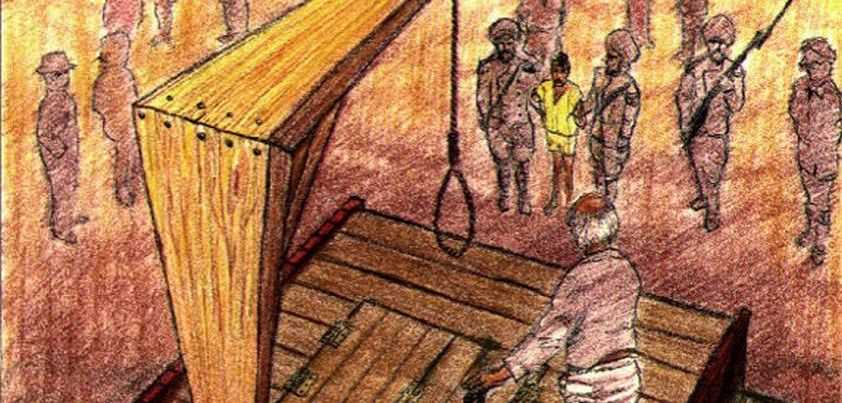 This story by Eric Arthur Blair (aka George Orwell) is a narrative essay providing an eyewitness account of an execution in 1920s Burma. By describing only what happens and not telling us the prisoner’s crime, Orwell supports the thesis that capital punishment cannot be justified under any circumstances. He cleverly uses irony to support his case, the most notable instance being the revelation that the jail official in charge of the hanging is a doctor. The narrator’s moment of enlightenment comes when the prisoner encounters a puddle of water on the path to the gallows. More…
This story by Eric Arthur Blair (aka George Orwell) is a narrative essay providing an eyewitness account of an execution in 1920s Burma. By describing only what happens and not telling us the prisoner’s crime, Orwell supports the thesis that capital punishment cannot be justified under any circumstances. He cleverly uses irony to support his case, the most notable instance being the revelation that the jail official in charge of the hanging is a doctor. The narrator’s moment of enlightenment comes when the prisoner encounters a puddle of water on the path to the gallows. More…
The Necessary Grace to Fall
 In this story by Gina Ochsner, an investigative assistant in the claims department of a life insurance company finds himself bored by both the routine of the job and his marriage. He compensates by taking a morbid interest in the unusual causes of death he encounters, and becomes obsessed with learning more about a woman from his childhood neighborhood who jumped/fell from a bridge. While sitting on a ledge of the same bridge trying to imagine her motivation and feelings, he has an epiphany that may change his life. Themes include alienation, guilt, death, suicide, obsession, redemption, hope. More…
In this story by Gina Ochsner, an investigative assistant in the claims department of a life insurance company finds himself bored by both the routine of the job and his marriage. He compensates by taking a morbid interest in the unusual causes of death he encounters, and becomes obsessed with learning more about a woman from his childhood neighborhood who jumped/fell from a bridge. While sitting on a ledge of the same bridge trying to imagine her motivation and feelings, he has an epiphany that may change his life. Themes include alienation, guilt, death, suicide, obsession, redemption, hope. More…
A Chip of Glass Ruby
 Some people see this Nadine Gordimer story as primarily an anti-apartheid tale. For me, the main theme is exemplified in Yusuf’s “aha moment” when he finally understands why his wife is not like the others. Gordimer shows apartheid for what it is by contrasting those behind it with an extra-ordinary, ordinary woman who doesn’t want anybody to be left out (people without somewhere to live, hungry kids, boys who can’t get educated) and cares enough to put herself at risk by doing something about it. The absence of a denouement in the story suggests that her fight isn’t yet over. More…
Some people see this Nadine Gordimer story as primarily an anti-apartheid tale. For me, the main theme is exemplified in Yusuf’s “aha moment” when he finally understands why his wife is not like the others. Gordimer shows apartheid for what it is by contrasting those behind it with an extra-ordinary, ordinary woman who doesn’t want anybody to be left out (people without somewhere to live, hungry kids, boys who can’t get educated) and cares enough to put herself at risk by doing something about it. The absence of a denouement in the story suggests that her fight isn’t yet over. More…
The Holiday
 This chapter from Lily Brett’s book Things Could Be Worse describes how several Jewish migrant couples meet at an inexpensive Australian holiday resort in 1950 and form a close-knit group that holidays together over the next thirty-two years. Despite their growing prosperity, they are still haunted by memories of the past. The group breaks up when a meddling member has a photograph taken that suggests the husband of one couple is having an affair with the wife of another. As couples take sides, relationships are destroyed for both members and their children. Themes include assimilation, friendship, memories, “Jewishness”, gossip-mongering, aging. More…
This chapter from Lily Brett’s book Things Could Be Worse describes how several Jewish migrant couples meet at an inexpensive Australian holiday resort in 1950 and form a close-knit group that holidays together over the next thirty-two years. Despite their growing prosperity, they are still haunted by memories of the past. The group breaks up when a meddling member has a photograph taken that suggests the husband of one couple is having an affair with the wife of another. As couples take sides, relationships are destroyed for both members and their children. Themes include assimilation, friendship, memories, “Jewishness”, gossip-mongering, aging. More…
Strawberry Spring
 In this story by Stephen King, a serial killer stalks women in a small college community. The murders, which always take place at night, become increasingly vicious. Set in a rare false (strawberry) spring, thick fog provides perfect cover for the killer. Panic sets in as students realize the killer could be anyone on campus. When the weather breaks, the murders stop. Eight years later, during the next strawberry spring, they begin anew and, in a memorable twist, the narrator thinks he knows the identity of the killer. Themes include violence, fear, rumor and paranoia, confusion, memory, dissociation. More…
In this story by Stephen King, a serial killer stalks women in a small college community. The murders, which always take place at night, become increasingly vicious. Set in a rare false (strawberry) spring, thick fog provides perfect cover for the killer. Panic sets in as students realize the killer could be anyone on campus. When the weather breaks, the murders stop. Eight years later, during the next strawberry spring, they begin anew and, in a memorable twist, the narrator thinks he knows the identity of the killer. Themes include violence, fear, rumor and paranoia, confusion, memory, dissociation. More…
The Conversion of the Jews
 The message of this satirical story by Philip Roth is applicable to all religions: the need to guard against zealotry. A teenaged Jewish boy is disciplined for suggesting that God could impregnate a woman without intercourse. He wasn’t questioning the Jewish belief that Jesus was a man, but rather asserting the power of God to do so. After being slapped for questioning his rabbi’s knowledge of God, the boy flees to the synagogue roof and finds a creative way to force the whole community to acknowledge his point of view. Themes include bigotry vs. tolerance, irreverence, search for truth, hypocrisy. More…
The message of this satirical story by Philip Roth is applicable to all religions: the need to guard against zealotry. A teenaged Jewish boy is disciplined for suggesting that God could impregnate a woman without intercourse. He wasn’t questioning the Jewish belief that Jesus was a man, but rather asserting the power of God to do so. After being slapped for questioning his rabbi’s knowledge of God, the boy flees to the synagogue roof and finds a creative way to force the whole community to acknowledge his point of view. Themes include bigotry vs. tolerance, irreverence, search for truth, hypocrisy. More…
In Paris
 In this story by Ivan Bunin, a well-to-do, middle-aged Russian exile becomes “animated” for the first time in years when he encounters a sophisticated Russian waitress in a Paris restaurant. Both live in isolation and solitude, having fled their homeland for supporting the wrong side in the Russian Civil War. A date at the cinema predictably leads to a steamy romance. The woman moves in with the man, but it is not until the tragic final paragraph that readers can appreciate how much she loved him. Themes include loss, isolation and loneliness, sexuality, love, mortality, despair, a community in exile. More…
In this story by Ivan Bunin, a well-to-do, middle-aged Russian exile becomes “animated” for the first time in years when he encounters a sophisticated Russian waitress in a Paris restaurant. Both live in isolation and solitude, having fled their homeland for supporting the wrong side in the Russian Civil War. A date at the cinema predictably leads to a steamy romance. The woman moves in with the man, but it is not until the tragic final paragraph that readers can appreciate how much she loved him. Themes include loss, isolation and loneliness, sexuality, love, mortality, despair, a community in exile. More…
The Handsomest Drowned Man in the World
 This story from Gabriel Marquez describes how the body of a huge man washed in from the sea transforms a drab, sleepy fishing village. The body goes through stages of being admired for its power and good looks, pitied for the inconvenience being so large must have caused, given a name, claimed by the village as one of its own, and re-buried at sea with great dignity. The people feel such pride in being associated with the unknown man that their celebrations of his life turn the village into a famous landmark. Themes: myth creation, perceptions and influence of beauty. More…
This story from Gabriel Marquez describes how the body of a huge man washed in from the sea transforms a drab, sleepy fishing village. The body goes through stages of being admired for its power and good looks, pitied for the inconvenience being so large must have caused, given a name, claimed by the village as one of its own, and re-buried at sea with great dignity. The people feel such pride in being associated with the unknown man that their celebrations of his life turn the village into a famous landmark. Themes: myth creation, perceptions and influence of beauty. More…
Heat
 In this confronting story by Joyce Carol Oates, mischievous eleven-year-old twin girls are brutally murdered by Roger Whipple, a supposedly harmless, mentally challenged man. Major themes are power, cruelty and violent revenge. The twins exercise persuasive power by demanding compliance with their wishes from school friends and cruelly harassing and making fun of Roger. The power theme is emphasized through anecdotes about the girls’ antics and dark humor: We liked it that Rhea and Rhoda had been killed … but we didn’t like it that they were dead; we missed them. In the end revenge, and Roger’s physical power, prevail. More…
In this confronting story by Joyce Carol Oates, mischievous eleven-year-old twin girls are brutally murdered by Roger Whipple, a supposedly harmless, mentally challenged man. Major themes are power, cruelty and violent revenge. The twins exercise persuasive power by demanding compliance with their wishes from school friends and cruelly harassing and making fun of Roger. The power theme is emphasized through anecdotes about the girls’ antics and dark humor: We liked it that Rhea and Rhoda had been killed … but we didn’t like it that they were dead; we missed them. In the end revenge, and Roger’s physical power, prevail. More…
Rape Fantasies
 This Margaret Atwood story makes extensive use of irony and dark humor to soften discussion of a serious topic. Set in a bar, the protagonist (Estelle) relates a lunchtime discussion she had with co-workers about rape fantasies. Two of them dream of erotic, romantic encounters, while another remains awkwardly silent. Estelle’s imagined attackers all have a physical or mental impediment requiring her help! Themes include gender stereotypes, vulnerability, complacency, and naivety (as exemplified by Estelle’s belief that having a conversation about rape with a man she meets in a bar will protect her against the real thing!) More…
This Margaret Atwood story makes extensive use of irony and dark humor to soften discussion of a serious topic. Set in a bar, the protagonist (Estelle) relates a lunchtime discussion she had with co-workers about rape fantasies. Two of them dream of erotic, romantic encounters, while another remains awkwardly silent. Estelle’s imagined attackers all have a physical or mental impediment requiring her help! Themes include gender stereotypes, vulnerability, complacency, and naivety (as exemplified by Estelle’s belief that having a conversation about rape with a man she meets in a bar will protect her against the real thing!) More…
Children of the Sea
 This story from Edwidge Danticat highlights the plight of refugees the world over who have been (and unfortunately still are) forced to flee their countries for speaking up about illegitimate and/or oppressive governments. The tragic, haunting tale comprises alternating journal entries by a student activist forced to flee Haiti by sea during the notorious Duvalier regime of the late 1950s, and the young woman he leaves behind. As his boat leaks, the girl’s family suffers and Haiti bleeds. Ironically, life on the boat proves almost as savage as on land. Themes: totalitarianism (violence, injustice, human rights abuse), love, sacrifice, death. More…
This story from Edwidge Danticat highlights the plight of refugees the world over who have been (and unfortunately still are) forced to flee their countries for speaking up about illegitimate and/or oppressive governments. The tragic, haunting tale comprises alternating journal entries by a student activist forced to flee Haiti by sea during the notorious Duvalier regime of the late 1950s, and the young woman he leaves behind. As his boat leaks, the girl’s family suffers and Haiti bleeds. Ironically, life on the boat proves almost as savage as on land. Themes: totalitarianism (violence, injustice, human rights abuse), love, sacrifice, death. More…
On the Way to Solomon’s Pools
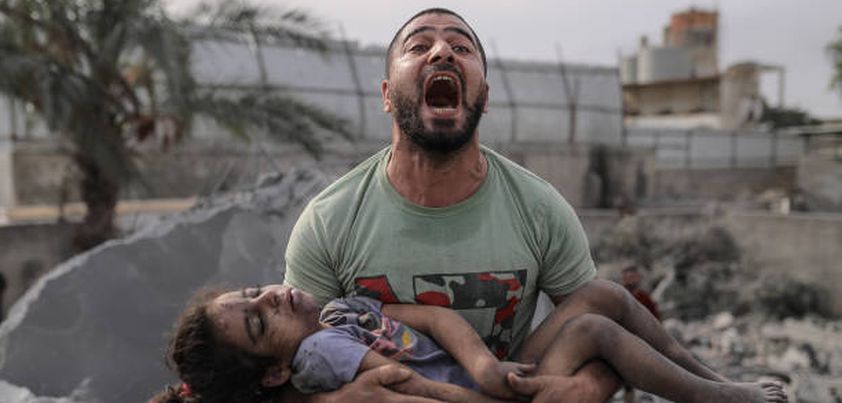 Themes of this story by Samira Azzam include bravery, defeat and hatred. Set during Palestine’s defense of its territories shortly after the formation of Israel, a schoolteacher/National Guardsman lays covering fire as other villagers escape. His wife courageously remains with him, urging him to stay strong. When his ammunition runs out, they flee. He carries their young son, his wife a few belongings. As they run towards safety, the boy is fatally shot. He runs ahead of his wife, steps off the road, buries the child in private, and loses his soul to hatred… not even offering a prayer. More…
Themes of this story by Samira Azzam include bravery, defeat and hatred. Set during Palestine’s defense of its territories shortly after the formation of Israel, a schoolteacher/National Guardsman lays covering fire as other villagers escape. His wife courageously remains with him, urging him to stay strong. When his ammunition runs out, they flee. He carries their young son, his wife a few belongings. As they run towards safety, the boy is fatally shot. He runs ahead of his wife, steps off the road, buries the child in private, and loses his soul to hatred… not even offering a prayer. More…
All Summer in a Day
 Set on the planet Venus, the climate in this Ray Bradbury story features almost constant rain. The only break comes every seven years, when there are two hours of sunshine. The children of the Earth space travel families on the planet are all looking forward to playing outside during the short break. Only one of them has ever seen the sun, and she is having great trouble dealing with the constant rain. But when the sun finally does come out, she is nowhere to be seen. Themes include adaptability, envy, reaction to differences, and bullying.. More…
Set on the planet Venus, the climate in this Ray Bradbury story features almost constant rain. The only break comes every seven years, when there are two hours of sunshine. The children of the Earth space travel families on the planet are all looking forward to playing outside during the short break. Only one of them has ever seen the sun, and she is having great trouble dealing with the constant rain. But when the sun finally does come out, she is nowhere to be seen. Themes include adaptability, envy, reaction to differences, and bullying.. More…
Shhhh
 In this story by NoViolet Bulawayo, a Zimbabwean girl is full of hatred when her father returns home terminally ill after years of no contact or family support. He is totally helpless and, because of his condition (AIDS), her mother forbids her to tell anyone he is back. There are few secrets in an African slum and, when her friends insist on seeing him, she fears they will treat him cruelly. To her surprise, they are respectful, gentle and caring, which begins to turn her feelings around. Themes include abandonment, hatred, fatal illness (AIDS), shame, secrecy, compassion, religion, church greed/corruption. More…
In this story by NoViolet Bulawayo, a Zimbabwean girl is full of hatred when her father returns home terminally ill after years of no contact or family support. He is totally helpless and, because of his condition (AIDS), her mother forbids her to tell anyone he is back. There are few secrets in an African slum and, when her friends insist on seeing him, she fears they will treat him cruelly. To her surprise, they are respectful, gentle and caring, which begins to turn her feelings around. Themes include abandonment, hatred, fatal illness (AIDS), shame, secrecy, compassion, religion, church greed/corruption. More…
The Way Up to Heaven
 This story by Roald Dahl is about a wealthy couple. Mrs Foster is a devoted wife who has a phobia about being late. Mr Foster is a dominating husband and likes to play cruel jokes on his wife by trying to make her late. In the end, Mrs Foster has the last laugh as her husband finds his way UP to Heaven. I love the irony in the way Mrs Foster ends her weekly letters to her husband from Paris: Now be sure to take your meals regularly, dear, although this is something I’m afraid you may not be doing… More…
This story by Roald Dahl is about a wealthy couple. Mrs Foster is a devoted wife who has a phobia about being late. Mr Foster is a dominating husband and likes to play cruel jokes on his wife by trying to make her late. In the end, Mrs Foster has the last laugh as her husband finds his way UP to Heaven. I love the irony in the way Mrs Foster ends her weekly letters to her husband from Paris: Now be sure to take your meals regularly, dear, although this is something I’m afraid you may not be doing… More…
A Wagner Matinée
 Willa Cather’s A Wagner Matinée highlights the gulf between the hard, isolated life of the American West’s early settlers and the civilized, cultured life of the cities they left behind. The contrast is even greater for the protagonist’s Aunt Georgiana who is not only highly educated, but also accomplished in and passionate about classical music. Her state of almost catatonic shock upon returning to the city and tearful reaction to the musical performance may also indicate regret over her rash elopement thirty years earlier. Themes: hardship, isolation, loneliness, kindness, appreciation, the inspirational/healing power of music. More…
Willa Cather’s A Wagner Matinée highlights the gulf between the hard, isolated life of the American West’s early settlers and the civilized, cultured life of the cities they left behind. The contrast is even greater for the protagonist’s Aunt Georgiana who is not only highly educated, but also accomplished in and passionate about classical music. Her state of almost catatonic shock upon returning to the city and tearful reaction to the musical performance may also indicate regret over her rash elopement thirty years earlier. Themes: hardship, isolation, loneliness, kindness, appreciation, the inspirational/healing power of music. More…
The Vane Sisters
 Readers often need to re-visit this Vladimir Nabokov story several times to grasp the nuances of the plot. The major characters are the haughty, misogynistic, first-person (and therefore unreliable) narrator and two sisters, one of whom strongly believes in the occult. Like other Nabokov stories, secret codes are involved. The acrostic message hidden in the final paragraph leaves readers wondering how much of the story came from the spirits of the then dead sisters. Themes include unfulfilled love, death, mourning, and interconnections (between memory and imagination, past and present, the real and spiritual worlds). More…
Readers often need to re-visit this Vladimir Nabokov story several times to grasp the nuances of the plot. The major characters are the haughty, misogynistic, first-person (and therefore unreliable) narrator and two sisters, one of whom strongly believes in the occult. Like other Nabokov stories, secret codes are involved. The acrostic message hidden in the final paragraph leaves readers wondering how much of the story came from the spirits of the then dead sisters. Themes include unfulfilled love, death, mourning, and interconnections (between memory and imagination, past and present, the real and spiritual worlds). More…
King of the Bingo Game
 This Ralph Ellison story opens with a poverty-stricken African-American man sitting in a theater waiting for the end-of-movie bingo game. He needs a win. His partner Laura is dying, and he has no money for medical treatment. The game begins and his numbers come up. When called onto the stage to spin a wheel of fortune to claim the prize, the hungry, alcohol affected man becomes delusional and creates a scene. Police intervene and, although the wheel stops on the jackpot number, he wins the game but not the money. Themes: identity (paranoia, alienation, desperation), prejudice, illusion, self-determination vs. fate. More…
This Ralph Ellison story opens with a poverty-stricken African-American man sitting in a theater waiting for the end-of-movie bingo game. He needs a win. His partner Laura is dying, and he has no money for medical treatment. The game begins and his numbers come up. When called onto the stage to spin a wheel of fortune to claim the prize, the hungry, alcohol affected man becomes delusional and creates a scene. Police intervene and, although the wheel stops on the jackpot number, he wins the game but not the money. Themes: identity (paranoia, alienation, desperation), prejudice, illusion, self-determination vs. fate. More…
The Moonlit Road
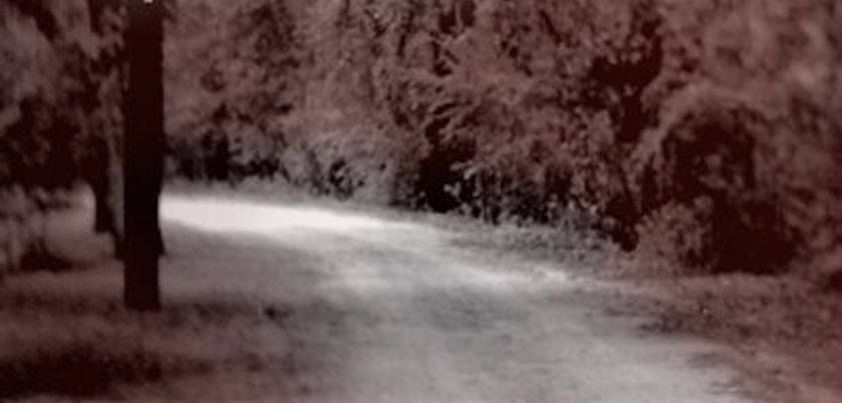 In this famous gothic horror story by Ambrose Bierce, a rich man has a loving wife who he does not trust. He sets a trap that doesn’t go as planned, resulting in him accidentally killing her. The unfortunate woman’s ghost, which is unaware who killed her, tries to contact him. This sets off a chain of events that ruins the lives of both the rich man and their only son. We hear the story from three perspectives: those of the son, a man we assume to be the husband/killer, and the ghost herself as told through a medium. More…
In this famous gothic horror story by Ambrose Bierce, a rich man has a loving wife who he does not trust. He sets a trap that doesn’t go as planned, resulting in him accidentally killing her. The unfortunate woman’s ghost, which is unaware who killed her, tries to contact him. This sets off a chain of events that ruins the lives of both the rich man and their only son. We hear the story from three perspectives: those of the son, a man we assume to be the husband/killer, and the ghost herself as told through a medium. More…
Seven Floors
 Dino Buzzati’s Seven Floors is an allegory of both the stages of life, and the futility of trying to fight bureaucracy. A slightly ill patient enters a ward on the top floor of a seven-story sanatorium. He learns that more seriously ill patients are progressively moved to lower floors, with the dying relegated to the dreaded first floor. Once caught up in the system, and against his perception of the severity of his illness, he makes the slow, inexorable progression to the bottom. Themes include the inevitability of ageing and death, institutional inflexibility, the unpredictability of life, fear. More…
Dino Buzzati’s Seven Floors is an allegory of both the stages of life, and the futility of trying to fight bureaucracy. A slightly ill patient enters a ward on the top floor of a seven-story sanatorium. He learns that more seriously ill patients are progressively moved to lower floors, with the dying relegated to the dreaded first floor. Once caught up in the system, and against his perception of the severity of his illness, he makes the slow, inexorable progression to the bottom. Themes include the inevitability of ageing and death, institutional inflexibility, the unpredictability of life, fear. More…
The Sphinx without a Secret
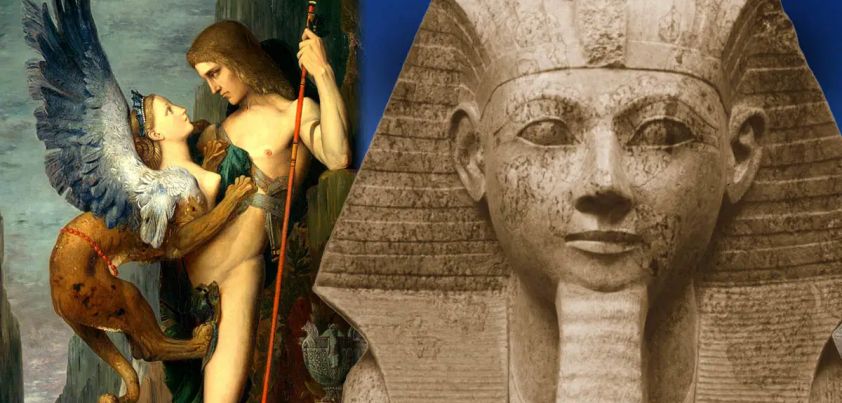 In this story by Oscar Wilde, two old college friends discuss a mysterious woman one of them had fallen in love with. The relationship ended when she refused to reveal the secret behind her apparent paranoia about being contacted at home and a clandestine visit to a boarding house. The major themes of the story are love and trust, as evidenced by the narrator’s initial comment: women are meant to be loved, not be understood and his friend’s retort: I cannot love where I cannot trust. Other themes include the allure of mystery, obsession, insecurity, jealousy, privacy, escape. More…
In this story by Oscar Wilde, two old college friends discuss a mysterious woman one of them had fallen in love with. The relationship ended when she refused to reveal the secret behind her apparent paranoia about being contacted at home and a clandestine visit to a boarding house. The major themes of the story are love and trust, as evidenced by the narrator’s initial comment: women are meant to be loved, not be understood and his friend’s retort: I cannot love where I cannot trust. Other themes include the allure of mystery, obsession, insecurity, jealousy, privacy, escape. More…
In the Kindergarten
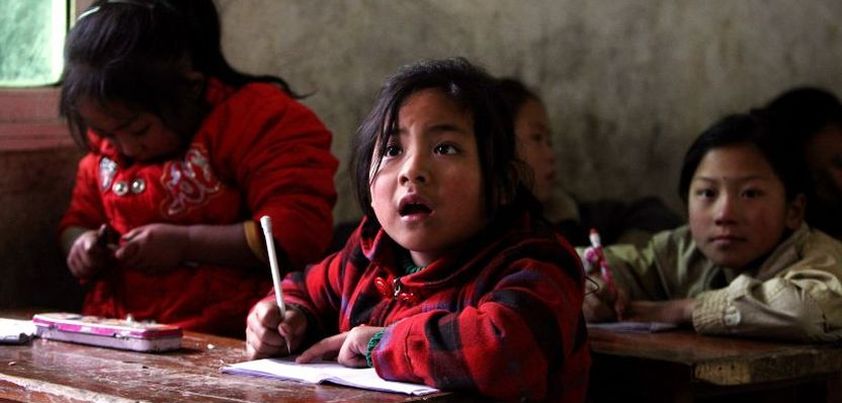 In this story by Ha Jin, a Chinese kindergarten student (Shaona) comes up with an unusual response to her teacher’s lies about herbs their class has been collecting. Major themes are (for Shaona) loneliness, uncertainty, alienation, adaption (for Shen) poverty, hunger, deception, betrayal. Shen may be a symbol of the Chinese authorities, her ‘poverty’ being a metaphor for greed. With no respect for the rules, she accumulates wealth (purslanes) through corruption and the toil of her charges. Shaona identifies several of Shen’s character traits, and puts two of them (bribery and deceit) to use in dealing with the class bully. More…
In this story by Ha Jin, a Chinese kindergarten student (Shaona) comes up with an unusual response to her teacher’s lies about herbs their class has been collecting. Major themes are (for Shaona) loneliness, uncertainty, alienation, adaption (for Shen) poverty, hunger, deception, betrayal. Shen may be a symbol of the Chinese authorities, her ‘poverty’ being a metaphor for greed. With no respect for the rules, she accumulates wealth (purslanes) through corruption and the toil of her charges. Shaona identifies several of Shen’s character traits, and puts two of them (bribery and deceit) to use in dealing with the class bully. More…
The Celebrated Jumping Frog
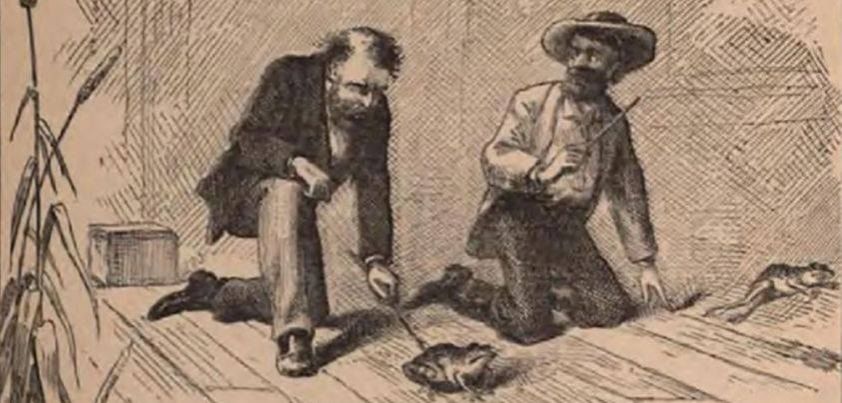 The humorous frame story of this unlikely tale by Samuel Clemens (aka Mark Twain) satirizes the way late nineteenth-century American “Easterners” looked down on their supposedly less sophisticated Western compatriots. In the inner story, a man named Jim loves gambling so much that he will bet on almost anything. He finds a frog he believes can leap further than any other in Calaveras County, and learns an expensive lesson when a passing stranger bets against his frog and wins easily. Themes include regional stereotypes, storytelling (tall-tales), gambling consequences (there’s no such thing as a sure bet), trickery and deception. More…
The humorous frame story of this unlikely tale by Samuel Clemens (aka Mark Twain) satirizes the way late nineteenth-century American “Easterners” looked down on their supposedly less sophisticated Western compatriots. In the inner story, a man named Jim loves gambling so much that he will bet on almost anything. He finds a frog he believes can leap further than any other in Calaveras County, and learns an expensive lesson when a passing stranger bets against his frog and wins easily. Themes include regional stereotypes, storytelling (tall-tales), gambling consequences (there’s no such thing as a sure bet), trickery and deception. More…
The Intoxicated Years
 This story by Mariana Enriquez is set during one of Argentina’s worst economic crises. As their parents struggle for economic survival and fight their own demons, three late-teenaged girls are given almost total freedom. With no respect for adults or their conventional peers, the thoroughly dislikeable trio pursue a hedonistic, drug and alcohol fueled lifestyle. The socially detached girls pledge a bond of “sisterhood”. When a punk rocker causes one of them to distance herself, the others exact violent retribution. Themes include alienation, social isolation, alternative culture, drug dealing and abuse, betrayal, revenge. More…
This story by Mariana Enriquez is set during one of Argentina’s worst economic crises. As their parents struggle for economic survival and fight their own demons, three late-teenaged girls are given almost total freedom. With no respect for adults or their conventional peers, the thoroughly dislikeable trio pursue a hedonistic, drug and alcohol fueled lifestyle. The socially detached girls pledge a bond of “sisterhood”. When a punk rocker causes one of them to distance herself, the others exact violent retribution. Themes include alienation, social isolation, alternative culture, drug dealing and abuse, betrayal, revenge. More…
The 13-Carat Diamond
 Khin Mya (aka Khin Myo Chit) is one of a small number of recognized Burmese (now Myanmars) authors who wrote in English as well as their native tongue. The story takes place during World War II at the time the Japanese occupied Burma. It tells of the humorous experiences of a young couple who are finding it hard to make ends meet. The woman fails at running a market stall, and comes up with a plan to become rich overnight. All she has to do is find someone with a 13-carat diamond they are willing sell. More…
Khin Mya (aka Khin Myo Chit) is one of a small number of recognized Burmese (now Myanmars) authors who wrote in English as well as their native tongue. The story takes place during World War II at the time the Japanese occupied Burma. It tells of the humorous experiences of a young couple who are finding it hard to make ends meet. The woman fails at running a market stall, and comes up with a plan to become rich overnight. All she has to do is find someone with a 13-carat diamond they are willing sell. More…
The Loaded Dog
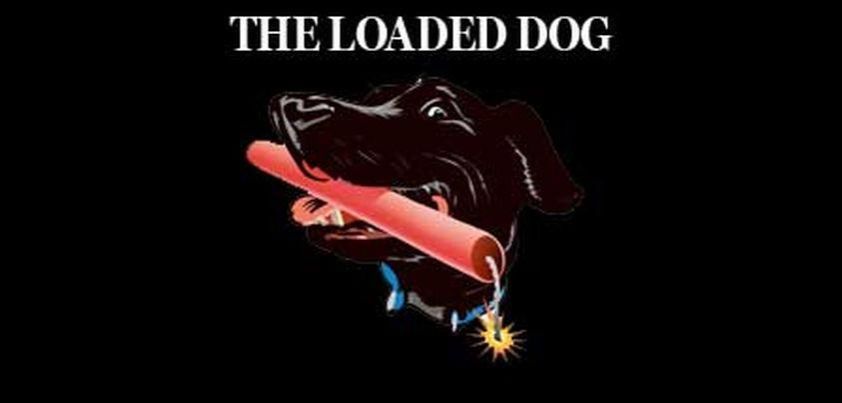 This is one of the best-known stories by Australian poet and writer, Henry Lawson. It takes place in the late 1800s and involves three men and their big, lovable retriever pup. The men are working together digging for gold and like to go fishing in their free time. When the fish stop biting, they decide to catch them by making a bomb and exploding it in the water. The pup picks up the bomb, accidentally lights the fuse as he runs past the campfire, and has great fun chasing the men around the gold fields trying to give it back. More…
This is one of the best-known stories by Australian poet and writer, Henry Lawson. It takes place in the late 1800s and involves three men and their big, lovable retriever pup. The men are working together digging for gold and like to go fishing in their free time. When the fish stop biting, they decide to catch them by making a bomb and exploding it in the water. The pup picks up the bomb, accidentally lights the fuse as he runs past the campfire, and has great fun chasing the men around the gold fields trying to give it back. More…
Slowly, Slowly in the Wind
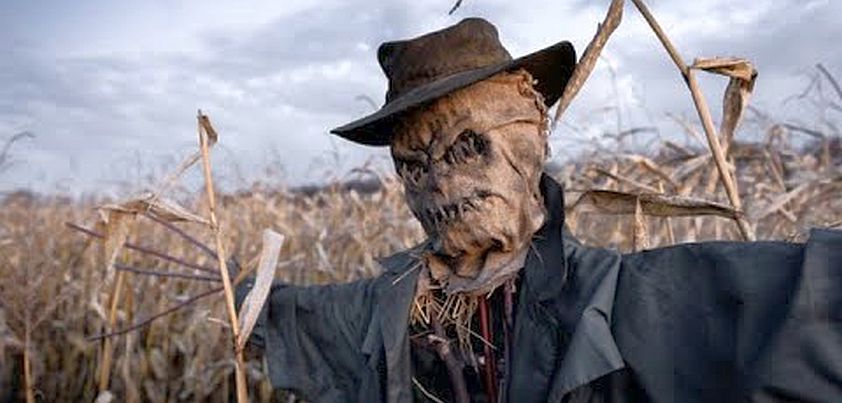 In this story by Patricia Highsmith, doctors warn “Skip” Skipperton, a notoriously bad-tempered business executive, to slow down or risk early death. His answer is to buy Coldstream Heights, a small but comfortable farm. Skip’s only problem is that the titular “stream” is a few meters inside a neighbor’s property, which the owner won’t sell or lease at any price. Not used to being refused, Skip is enraged. When his beloved daughter elopes with the neighbor’s son, he kills the old man. Unfortunately for Skip, the murder is exposed by a children’s Halloween prank. Themes: anger, narcissism, pride, revenge, justice. More…
In this story by Patricia Highsmith, doctors warn “Skip” Skipperton, a notoriously bad-tempered business executive, to slow down or risk early death. His answer is to buy Coldstream Heights, a small but comfortable farm. Skip’s only problem is that the titular “stream” is a few meters inside a neighbor’s property, which the owner won’t sell or lease at any price. Not used to being refused, Skip is enraged. When his beloved daughter elopes with the neighbor’s son, he kills the old man. Unfortunately for Skip, the murder is exposed by a children’s Halloween prank. Themes: anger, narcissism, pride, revenge, justice. More…
Talpa
 The major themes of this story by Juan Rulfo, which some see as a religious allegory, are faith, conspiracy to cause death, suffering, betrayal, adultery and remorse. The wife and brother of a man dying slowly from a painful, weeping skin condition agree to take him on a pilgrimage to a famous religious shrine. They are in an adulterous relationship and, knowing the trip will kill him, hope to be together sooner. The man begs to return several times during the increasingly painful journey, but the pitiless couple drive him on. When he eventually does die, they return home disappointed. More…
The major themes of this story by Juan Rulfo, which some see as a religious allegory, are faith, conspiracy to cause death, suffering, betrayal, adultery and remorse. The wife and brother of a man dying slowly from a painful, weeping skin condition agree to take him on a pilgrimage to a famous religious shrine. They are in an adulterous relationship and, knowing the trip will kill him, hope to be together sooner. The man begs to return several times during the increasingly painful journey, but the pitiless couple drive him on. When he eventually does die, they return home disappointed. More…
Overcoat
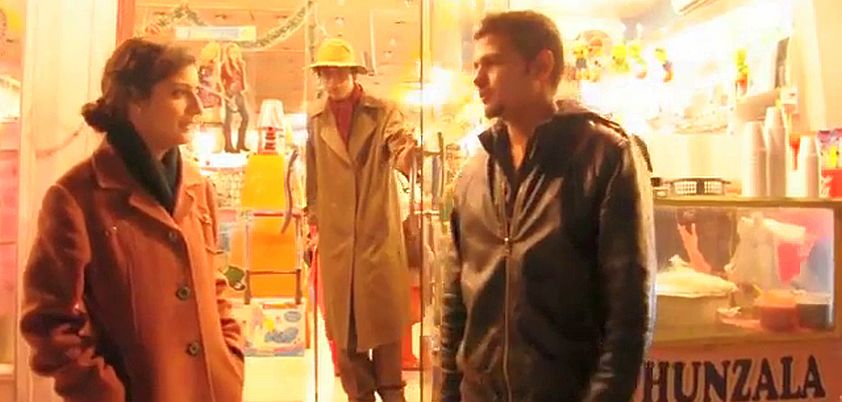 The major theme of this story by Ghulam Abbas is how people judge others by their appearance. A clearly impoverished man uses an overcoat, scarf and cane to create the persona of a well-to-do dandy. He enjoys a leisurely stroll through the streets of Lahore, and is welcomed in shops he could not otherwise enter. Importantly, the reader is also taken in by the guise until it is stripped away as his clothes are removed in hospital. Other themes include loneliness, social class, the human desire to “fit in” and be treated with respect, the unpredictability of life and death. More…
The major theme of this story by Ghulam Abbas is how people judge others by their appearance. A clearly impoverished man uses an overcoat, scarf and cane to create the persona of a well-to-do dandy. He enjoys a leisurely stroll through the streets of Lahore, and is welcomed in shops he could not otherwise enter. Importantly, the reader is also taken in by the guise until it is stripped away as his clothes are removed in hospital. Other themes include loneliness, social class, the human desire to “fit in” and be treated with respect, the unpredictability of life and death. More…
Naga
 In this story by R. K. Narayan, a widowed Indian snake charmer trains a monkey for his young son so the two can work together entertaining people in the streets. All goes well until the father runs away with a strumpet in a blue sari, taking the monkey with him. Left alone with the snake, which has grown too old to perform, the boy misses the monkey more than his father. He reluctantly keeps the snake after realizing it can’t survive in the wild, and looks for another kind of work. Themes include poverty, selfishness, abandonment, independence, loyalty, compassion. More…
In this story by R. K. Narayan, a widowed Indian snake charmer trains a monkey for his young son so the two can work together entertaining people in the streets. All goes well until the father runs away with a strumpet in a blue sari, taking the monkey with him. Left alone with the snake, which has grown too old to perform, the boy misses the monkey more than his father. He reluctantly keeps the snake after realizing it can’t survive in the wild, and looks for another kind of work. Themes include poverty, selfishness, abandonment, independence, loyalty, compassion. More…
The Possibility of Evil
 The major theme of this Shirley Jackson story is that appearances can be misleading. A secondary theme, which is particularly relevant these days, is ‘fake news’. Miss Strangeworth, who possibly suffers from OCD, believes that her letters, although based purely on suspicion, are for the good of the community. Her objective may be noble, but many of the thoughts expressed are evil. The story’s message is two-fold: 1) we must be constantly on guard against the “possibility of evil”; and 2) evil is sometimes committed under the guise of seemingly good causes. Other themes: heritage, haughtiness, alienation, community, revenge. More…
The major theme of this Shirley Jackson story is that appearances can be misleading. A secondary theme, which is particularly relevant these days, is ‘fake news’. Miss Strangeworth, who possibly suffers from OCD, believes that her letters, although based purely on suspicion, are for the good of the community. Her objective may be noble, but many of the thoughts expressed are evil. The story’s message is two-fold: 1) we must be constantly on guard against the “possibility of evil”; and 2) evil is sometimes committed under the guise of seemingly good causes. Other themes: heritage, haughtiness, alienation, community, revenge. More…
The New Dress
 Virginia Woolf’s middle-aged, lower middle-class protagonist has gone to great lengths to have the perfect dress made for an upper middle-class party. The moment she arrives, she sees that the dress is “not right”. Highly embarrassed, she imagines everyone is mocking her. At first, she blames her situation on her working class upbringing and fantasizes about what might have been if her family had been wealthy. Then, in a moment of introspection, she remembers the good times in her life, commits to a plan for self-improvement, and leaves the party early. Themes: insecurity, self-consciousness, class, poverty, alienation, self-discovery. More…
Virginia Woolf’s middle-aged, lower middle-class protagonist has gone to great lengths to have the perfect dress made for an upper middle-class party. The moment she arrives, she sees that the dress is “not right”. Highly embarrassed, she imagines everyone is mocking her. At first, she blames her situation on her working class upbringing and fantasizes about what might have been if her family had been wealthy. Then, in a moment of introspection, she remembers the good times in her life, commits to a plan for self-improvement, and leaves the party early. Themes: insecurity, self-consciousness, class, poverty, alienation, self-discovery. More…
My Kinsman, Major Molineux
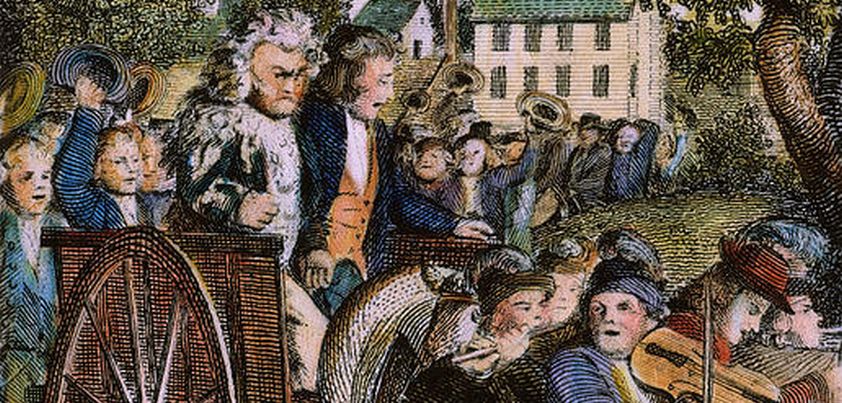 This Nathaniel Hawthorne story is set in the unsettling times shortly before the American Revolution. A naïve eighteen-year-old man travels from the countryside to an unnamed town seeking promised favors from Major Molineux, a distant relative and officer in the British army. Whenever he enquires about the Major’s address, he is met with either scorn or an evasive answer. He learns why when his tarred-and-feathered kinsman is led past him in a street parade. Fortunately, thanks to a kind stranger, there is still a possible future for him in the town. Themes: hope, political unrest, disorder, loss of innocence, compassion. More…
This Nathaniel Hawthorne story is set in the unsettling times shortly before the American Revolution. A naïve eighteen-year-old man travels from the countryside to an unnamed town seeking promised favors from Major Molineux, a distant relative and officer in the British army. Whenever he enquires about the Major’s address, he is met with either scorn or an evasive answer. He learns why when his tarred-and-feathered kinsman is led past him in a street parade. Fortunately, thanks to a kind stranger, there is still a possible future for him in the town. Themes: hope, political unrest, disorder, loss of innocence, compassion. More…
A Family Supper
 A common feature of Kazuo Ishiguro stories is their ambiguous endings. A young Japanese man returns home after living in America following a falling out with his parents. His mother has died from eating poisonous fugu fish, and his father feels disgraced over the collapse of his business. As a matter of honour, his business partner killed his family and committed suicide following the collapse. At the end of the day, the family sits down to a delicious fish supper prepared by the father. Themes include change (heritage and tradition vs. modernity), generational conflict, family disconnection, grief, guilt, “honour”, murder-suicide. More…
A common feature of Kazuo Ishiguro stories is their ambiguous endings. A young Japanese man returns home after living in America following a falling out with his parents. His mother has died from eating poisonous fugu fish, and his father feels disgraced over the collapse of his business. As a matter of honour, his business partner killed his family and committed suicide following the collapse. At the end of the day, the family sits down to a delicious fish supper prepared by the father. Themes include change (heritage and tradition vs. modernity), generational conflict, family disconnection, grief, guilt, “honour”, murder-suicide. More…
The Weight of a Gun
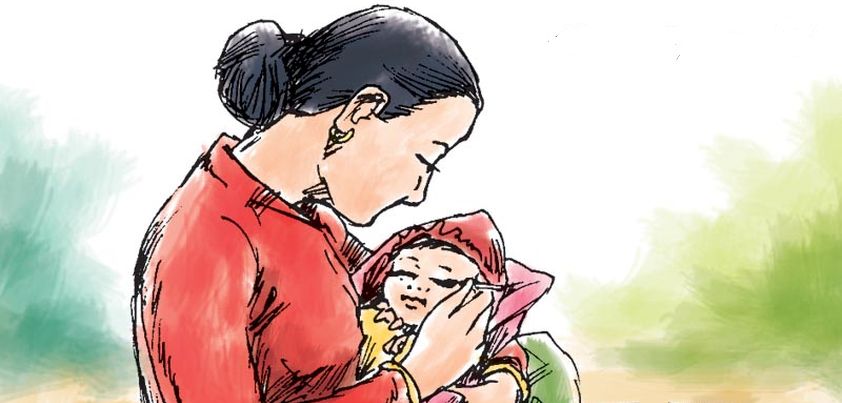 In this emotionally charged story by Samrat Upadhyay, a divorced woman tries desperately to prevent her schizophrenic adult son from self-harming or harming others. When she discovers that he has bought a gun and possibly joined Maoist rebels, she seeks help from his father. In the process, she befriends his pregnant, emotionally overwrought new wife who is being shunned by her family. As soon as the baby is born, the new wife does a runner and the husband follows, “temporarily” leaving the baby in her care. Themes include motherhood and motherly love, mental illness, loneliness and isolation, insensitivity, anxiety, superstition. More…
In this emotionally charged story by Samrat Upadhyay, a divorced woman tries desperately to prevent her schizophrenic adult son from self-harming or harming others. When she discovers that he has bought a gun and possibly joined Maoist rebels, she seeks help from his father. In the process, she befriends his pregnant, emotionally overwrought new wife who is being shunned by her family. As soon as the baby is born, the new wife does a runner and the husband follows, “temporarily” leaving the baby in her care. Themes include motherhood and motherly love, mental illness, loneliness and isolation, insensitivity, anxiety, superstition. More…
Marigolds
 In Eugenia Collier’s Marigolds the protagonist comes of age (or in her words loses her innocence) when caught in a senseless act of destruction. Angry about her father’s shame over not being able to find work, she lashes out at the garden of a neighbor who is trying to bring beauty and happiness into her life by growing marigolds. Ironically, the neighbor and her disabled son are even more destitute than the protagonist’s family. Themes: childhood memories, poverty, shame, envy, impulsiveness, empathy, guilt and possibly racism (the resentful references to “white folks” and comments about Miss Lottie’s “Indian-like” features). More…
In Eugenia Collier’s Marigolds the protagonist comes of age (or in her words loses her innocence) when caught in a senseless act of destruction. Angry about her father’s shame over not being able to find work, she lashes out at the garden of a neighbor who is trying to bring beauty and happiness into her life by growing marigolds. Ironically, the neighbor and her disabled son are even more destitute than the protagonist’s family. Themes: childhood memories, poverty, shame, envy, impulsiveness, empathy, guilt and possibly racism (the resentful references to “white folks” and comments about Miss Lottie’s “Indian-like” features). More…
How Much Land Does a Man Need?
 In this Leo Tolstoy story, a Russian peasant thinks to himself: Our only trouble is that we haven’t enough land. If I had a lot of land, I shouldn’t fear the Devil himself! The Devil ‘overhears’ this and puts him to the test. The more land the man gets, the more he thinks he needs. He hears of a place where for almost nothing you can buy all the land you can walk around in a day. In rushing to encircle as much land as possible, he learns the answer to the titular question. Themes: class, exploitation, temptaion, envy, avarice. More…
In this Leo Tolstoy story, a Russian peasant thinks to himself: Our only trouble is that we haven’t enough land. If I had a lot of land, I shouldn’t fear the Devil himself! The Devil ‘overhears’ this and puts him to the test. The more land the man gets, the more he thinks he needs. He hears of a place where for almost nothing you can buy all the land you can walk around in a day. In rushing to encircle as much land as possible, he learns the answer to the titular question. Themes: class, exploitation, temptaion, envy, avarice. More…
Wasps’ Nest
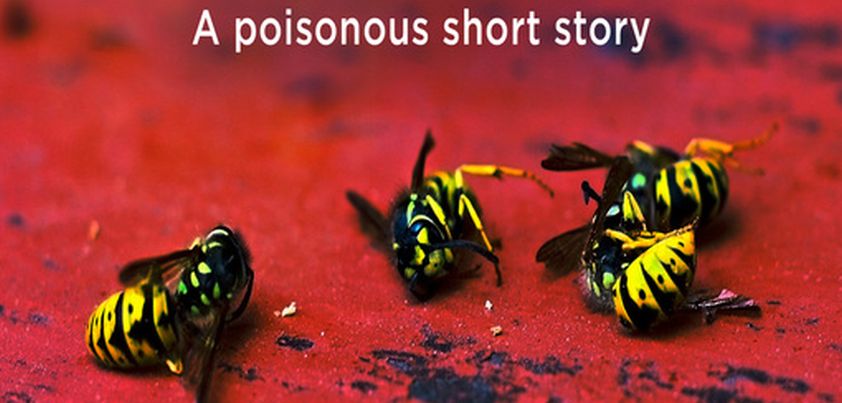 Today we are featuring a story from the great Agatha Christie. Unusually for a detective story, it involves an investigation into a murder that is yet to be committed. Hercule Poirot makes a surprise visit to an old friend and asks him to help prevent the murder. When told that the plot involves a friend of the man who has reason to hate him, he refuses to believe Poirot. Thanks to some very unlikely coincidences and skills learned from a grateful pickpocket, Poirot prevents both the murder and a suicide. Themes: friendship, rivalry, hatred, revenge, redemption, xenophobia. More…
Today we are featuring a story from the great Agatha Christie. Unusually for a detective story, it involves an investigation into a murder that is yet to be committed. Hercule Poirot makes a surprise visit to an old friend and asks him to help prevent the murder. When told that the plot involves a friend of the man who has reason to hate him, he refuses to believe Poirot. Thanks to some very unlikely coincidences and skills learned from a grateful pickpocket, Poirot prevents both the murder and a suicide. Themes: friendship, rivalry, hatred, revenge, redemption, xenophobia. More…
The Distance of the Moon
 This Italo Calvino story is a set in the imaginary past when the moon came close enough to earth each month for people to climb onto it. For some reason, this could only be done by ladder from a boat. The plot involves a love triangle within a group of people who regularly sail out to collect ‘moon-milk’. At the center of the triangle is the captain’s wife, who becomes stranded on the moon as it moves permanently away. The captain seems pleased to be rid of her, but not so the protagonist. This is magical realism at its best. More…
This Italo Calvino story is a set in the imaginary past when the moon came close enough to earth each month for people to climb onto it. For some reason, this could only be done by ladder from a boat. The plot involves a love triangle within a group of people who regularly sail out to collect ‘moon-milk’. At the center of the triangle is the captain’s wife, who becomes stranded on the moon as it moves permanently away. The captain seems pleased to be rid of her, but not so the protagonist. This is magical realism at its best. More…
The Jungle
 The “jungle” in this story by Elizabeth Bowen is a sealed-off area of woods overgrown with tussocks of bramble (blackberry bush) near an English boarding school. It becomes a secret haven for a lonely student, a fifteen-year-old girl who has difficulty maintaining friendships with others in her class. Things change when she breaks tradition and bonds with a girl in another class. The relationship has its ups and downs, largely because of her new friend’s assertiveness, and culminates in an implied sexual awakening in the jungle. Themes include alienation, teenage relationships, social class, escape, sexuality. More…
The “jungle” in this story by Elizabeth Bowen is a sealed-off area of woods overgrown with tussocks of bramble (blackberry bush) near an English boarding school. It becomes a secret haven for a lonely student, a fifteen-year-old girl who has difficulty maintaining friendships with others in her class. Things change when she breaks tradition and bonds with a girl in another class. The relationship has its ups and downs, largely because of her new friend’s assertiveness, and culminates in an implied sexual awakening in the jungle. Themes include alienation, teenage relationships, social class, escape, sexuality. More…
May Day Eve
 The major theme of this story by Nick Joaquin is that happy marriages don’t happen by magic; they require a foundation of mutual respect and constant effort on both sides. A wealthy, controlling man marries a beautiful, feisty, free-spirited woman. Set in late 1800s Philippines under Spanish (Catholic) rule, there is no way out as things go wrong. The woman likens their marriage to living in hell. Her resulting bitterness prompts the vindictive man to label her a witch. After her death, he breaks into tears when thinking about what might have been. Other themes: superstition, compatibility, aging, death, regret. More…
The major theme of this story by Nick Joaquin is that happy marriages don’t happen by magic; they require a foundation of mutual respect and constant effort on both sides. A wealthy, controlling man marries a beautiful, feisty, free-spirited woman. Set in late 1800s Philippines under Spanish (Catholic) rule, there is no way out as things go wrong. The woman likens their marriage to living in hell. Her resulting bitterness prompts the vindictive man to label her a witch. After her death, he breaks into tears when thinking about what might have been. Other themes: superstition, compatibility, aging, death, regret. More…
The Life You Save May Be Your Own
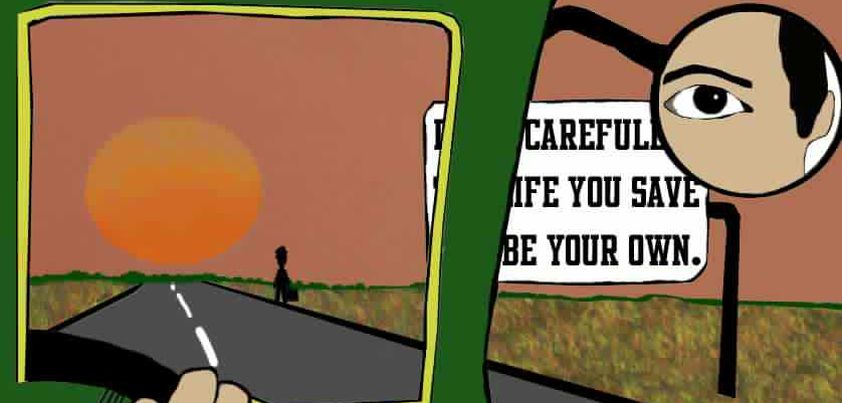 In this Flannery O’Connor story a cynical, manipulative, one-armed drifter is given a chance at redemption (settling down to a “better” life) by an equally manipulative mother desperate to secure a future for her mentally handicapped daughter. Rather than the daughter, the man only has eyes for the family’s “barn-find” automobile. Immediately after their wedding, he leaves the girl to an uncertain future at a roadside diner and drives on alone. Perhaps out of guilt, he unsuccessfully tries to absolve himself from the moral consequences of his actions by doing a good deed. Themes: disability, devotion, desperation, deception, redemption, independence. More…
In this Flannery O’Connor story a cynical, manipulative, one-armed drifter is given a chance at redemption (settling down to a “better” life) by an equally manipulative mother desperate to secure a future for her mentally handicapped daughter. Rather than the daughter, the man only has eyes for the family’s “barn-find” automobile. Immediately after their wedding, he leaves the girl to an uncertain future at a roadside diner and drives on alone. Perhaps out of guilt, he unsuccessfully tries to absolve himself from the moral consequences of his actions by doing a good deed. Themes: disability, devotion, desperation, deception, redemption, independence. More…
The Homemaker / Gharwali
 In this story by Ismat Chughtai, an orphan growing up on the streets learns that her body is her only asset. Alluring and without shame, she is known for providing sex for money, on credit, or as charity. Things change when a friend suggests that a respectable shopkeeper employ her as a housemaid. He refuses because of her reputation, but she is so taken by what she sees after visiting his house that she stays despite his protests and takes over the household. Themes include promiscuity, reputation, hypocrisy, desire, marriage, patriarchy, jealousy, the importance of “belonging”. More…
In this story by Ismat Chughtai, an orphan growing up on the streets learns that her body is her only asset. Alluring and without shame, she is known for providing sex for money, on credit, or as charity. Things change when a friend suggests that a respectable shopkeeper employ her as a housemaid. He refuses because of her reputation, but she is so taken by what she sees after visiting his house that she stays despite his protests and takes over the household. Themes include promiscuity, reputation, hypocrisy, desire, marriage, patriarchy, jealousy, the importance of “belonging”. More…
Gusev
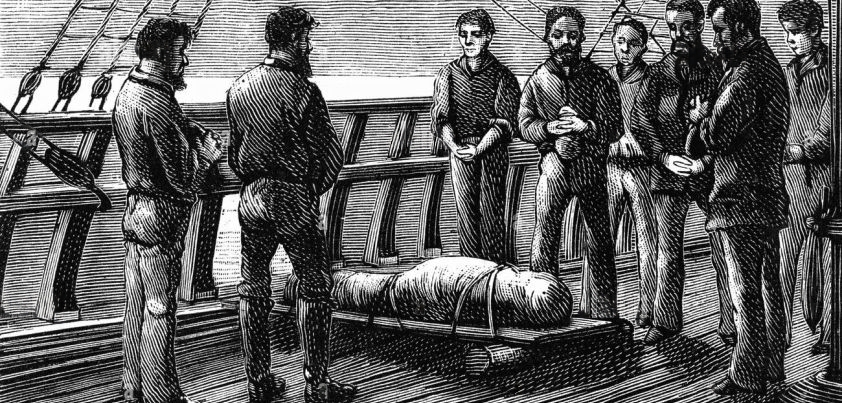 This Anton Chekhov story contrasts the attitudes towards social injustice of two Russian soldiers returning home by ship after serving in the Far East. Both are dying of tuberculosis, and neither survives the voyage. One (Gusev) is an uneducated, superstitious peasant who passively accepts his lot. The other (Pavel Ivanovich) is a bitter, fallen intellectual who looks down on “lesser” men and claims to actively oppose the Russian social system. Themes include social class, passivity vs. activism, memory and imagination, loneliness and alienation, the inconsequence of human suffering and death in the context of the glory of nature. More…
This Anton Chekhov story contrasts the attitudes towards social injustice of two Russian soldiers returning home by ship after serving in the Far East. Both are dying of tuberculosis, and neither survives the voyage. One (Gusev) is an uneducated, superstitious peasant who passively accepts his lot. The other (Pavel Ivanovich) is a bitter, fallen intellectual who looks down on “lesser” men and claims to actively oppose the Russian social system. Themes include social class, passivity vs. activism, memory and imagination, loneliness and alienation, the inconsequence of human suffering and death in the context of the glory of nature. More…
Babylon Revisited
 The protagonist in this bittersweet story from F. Scott Fitzgerald is in the process of rebuilding his life after losing everything in the aftermath of the 1929 stock market cash. Along with many other Americans caught up in the hedonistic 1920s Paris lifestyle, he had partied hard and drank to excess. When his wife died as he was recovering in a sanitarium, he was forced to give up custody of his then seven-year-old daughter. Two years later, he is determined to win her back. Themes: alcohol abuse and reform, wealth and poverty, fatherly love, self-discipline, alienation, guilt and regret, hope. More…
The protagonist in this bittersweet story from F. Scott Fitzgerald is in the process of rebuilding his life after losing everything in the aftermath of the 1929 stock market cash. Along with many other Americans caught up in the hedonistic 1920s Paris lifestyle, he had partied hard and drank to excess. When his wife died as he was recovering in a sanitarium, he was forced to give up custody of his then seven-year-old daughter. Two years later, he is determined to win her back. Themes: alcohol abuse and reform, wealth and poverty, fatherly love, self-discipline, alienation, guilt and regret, hope. More…
The Lone Ranger and Tonto Fistfight in Heaven
 This story by Sherman Alexie highlights the difficulty tribal Native-Americans have assimilating into American society. A Spokane Indian recalls his breakup with a white kindergarten teacher he loved. Their relationship was one of constant fights and arguments, often over his excessive drinking. Tortured by violent dreams, he returned to the community of the reservation. After several idle months he once again finds work in the outside world, where a call from his ex-girlfriend suggests they still have feelings for one another but are too afraid to pursue them. Themes include community vs. isolation, prejudice, alcohol abuse, love and hatred. More…
This story by Sherman Alexie highlights the difficulty tribal Native-Americans have assimilating into American society. A Spokane Indian recalls his breakup with a white kindergarten teacher he loved. Their relationship was one of constant fights and arguments, often over his excessive drinking. Tortured by violent dreams, he returned to the community of the reservation. After several idle months he once again finds work in the outside world, where a call from his ex-girlfriend suggests they still have feelings for one another but are too afraid to pursue them. Themes include community vs. isolation, prejudice, alcohol abuse, love and hatred. More…